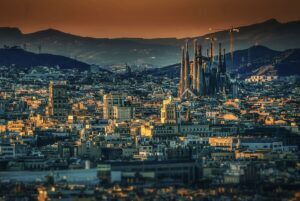Day 1 (October 20)
Arrive in Barcelona from our original departure points and settle into our hotel and amenities. Enjoy an evening meal for the first time as a traveling group.
Day 2 (October 21)
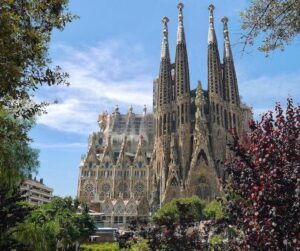
Sagrada Familia. Patrice Audet, Pixabay
Barcelona – Casa Battlo & La Sagrada Familia
After breakfast start your trip to Barcelona with a visit to Casa Batlló, a building in the center of Barcelona. It was designed by Antoni Gaudí, and is considered one of his masterpieces. Throughout the tour you’ll see Gaudi influence on architecture all over the city. A remodel of a previously built house, it was redesigned in 1904 by Gaudí and has been refurbished several times after that.
After a break for lunch, we will visit the most iconic Gaudi architecture in the city. The Basílica i Temple Expiatori de la Sagrada Família, also known as the Sagrada Família, is a large unfinished minor basilica in the Eixample district of Barcelona. This magnificent edifice is a UNESCO World Heritage Site.
Day 3 (October 22)
Barcelona – Fundación Joan Miro, Montjuic & Picasso Museum
After breakfast head over to Fundació Joan Miró, a museum of modern art honoring Joan Miró located on the hill called Montjuïc. After the museum continue to explore Montjuic until lunch.
After lunch, head over to the Picasso Museum, housing one of the most extensive collections of artworks by Pablo Picasso. With 4,251 works exhibited by the painter, the museum has one of the most complete permanent collections of his works. Later have dinner at a quaint local café and head back to your hotel.
Day 4 (October 23)
Barcelona – Catedral de Barcelona & Santa Maria del Mar, Museu d’Historia de Barcelona & Gothic Quarter
This morning, after breakfast, visit the Cathedral of Barcelona, the Gothic cathedral and seat of the Archbishop of Barcelona, Catalonia, Spain. The cathedral was constructed from the thirteenth to fifteenth centuries, with the principal work done in the fourteenth century.
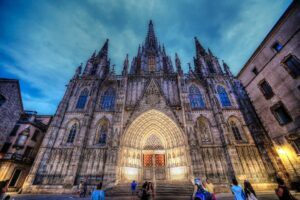
Cathedral of Barcelona. Catharinarytter, Pixabay
Next, head over to Santa Maria del Mar, a church in the Ribera district of Barcelona, Spain, built between 1329 and 1383 at the height of the Principality of Catalonia’s maritime and mercantile pre-eminence. It is an outstanding example of Catalan Gothic, with a purity and unity of style that is very unusual in large medieval buildings.
Afterwards get lunch and head over to the Museu d’Historia de Barcelona and after the museum, we make stops at Placa del Rei square and the ancient Roman Temple d’August. Then we will explore the Gothic Quarter of Barcelona and get dinner at a local café before heading back to the hotel.
Day 5 (October 24)
A day at Montserrat
Travel through to the breathtaking multi-peaked mountain range of Montserrat. Board a cogwheel train, visit a historic monastery on the Montserrat mountain range, and admire some incredible views. Later, return to your hotel in Barcelona.
Day 6 (October 25)
Off to Madrid
Today we fly to Madrid from Barcelona to begin our journey to other historic and prehistoric sites to the west away from the Barcelona coastal area. We will board a coach to travel northward to the historic city of Burgos, where we will settle in at our hotel with possible optional free time to explore the city. Enjoy an included evening dinner together.
Day 7 (October 26)
Burgos
Today after breakfast we head into Burgos to see key historic sites, accompanied and led by a special guest/lecturer, Dr. Amalia Perez-Juez. Among other points of interest, Burgos is rich in historic churches and convents, such as the great (Gothic) Burgos Cathedral, the Monasterio de las Huelgas Reales, and the Carthusian monastery, Miraflores Charterhouse (Cartuja de Miraflores). We will also visit the Castle of Burgos, where archaeological and historic research activities have revealed a long human occupation at the site ranging as far back as the European Early Bronze Age through to the early 19th century. Grab lunch during the day’s visits and enjoy a group dinner in the evening, and enjoy an evening lecture from our guide/lecturer.
Day 8 (October 27)
Burgos: Museum of Human Evolution & Atapuerca
Today have a good breakfast and, with the guidance of our guest/lecturer Amalia Perez-Juez, head straight to the Museum of Human Evolution. This museum exhibits, among many other things, the discoveries and finds from the world-famous Atapuerca excavation sites located 16 kilometers to the east.
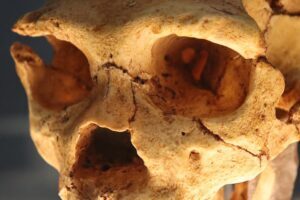
Skull detail of Homo heidelbergensis, a hominin discovered in the Sima de los Huesos cave system at Atapuerca. Fernando Losada Rodríguez, Creative Commons Attribution-Share Alike 4.0 International, Wikimedia Commons
After the museum grab lunch and head over to the Atapuerca excavation sites. The archaeological sites of Atapuerca are notable for evidence of early human occupation, including artifacts and fossils that attest to the earliest hominin (early relatives of humans) presence in Western Europe. The sites have produced arguably one of the world’s most prolific collections of fossils bearing on human evolution. Atapuerca was designated a World Heritage Site in 2000. After the visits have dinner and head to the hotel.
Day 9 (October 28)
Today we arise to breakfast and then depart to travel northward to the Cantabria region. Here we will settle into our hotel in Santillana del Mar, have lunch, and enjoy some free time in the historic town.
Day 10 (October 29)
Cantabria: Caves of Monte Castillo & Puente Viesgo
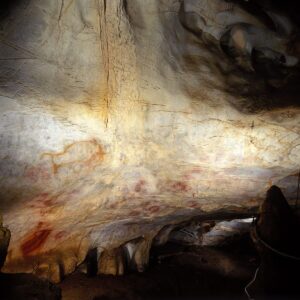
Interior detail of main room in Cueva del Castillo. Gabinete de Prensa del Gobierno de Cantabria, Creative Commons Attribution 3.0 Spain, Wikimedia Commons
After breakfast this morning, accompanied by our special guest/lecturer archaeologist Dr. Joao Zilhao, we will visit the Caves of Monte Castillo, an archaeological site that evidences prehistoric human occupation going back more than 35,000 years. The archaeological stratigraphy has been divided into around 19 layers, beginning in the Proto-Aurignacian, and ending in the Bronze Age. (Only small groups are allowed into the caves. Depending on the size of our overall group, we may need to split the group into 2. The first group will visit El Castillo while the other visit Las Monedas, and then the groups will swap).
After the caves, grab lunch at a local café in the town of Puente Viesgo. Later, we will have free time in Santillana del Mar.
Day 11 (October 30)
Cantabria: Cave of Altamira & Santillana del Mar
Today after breakfast head over to the replica and museum of the Cave of Altamira with Dr. Zilhao. Altamira is a cave complex located near Santillana del Mar. The original cave has been closed to the public for conservation purposes. This cave is renowned for prehistoric parietal cave art featuring charcoal drawings and polychrome paintings of contemporary local fauna and human hands. The earliest paintings were applied during the Upper Paleolithic, around 36,000 years ago.
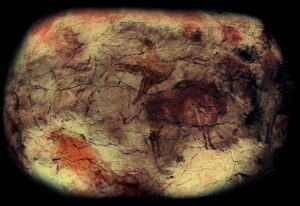
Replica of interior detail, cave painting in Altamira cave. José-Manuel Benito, Public Domain, Wikimedia Commons
After the caves, grab lunch and have more time to explore the historic town of Santillana del Mar before heading back to your hotel in Cantabria to settle in and have dinner.
In the evening, enjoy a lecture by Dr. Zilhao about his research and the discoveries in which he took part.
Day 12 (October 31)
Off to Bilbao – Casco Viejo
Today after breakfast we go by motor coach to Bilbao and enjoy the Spanish countryside along the way. Once we arrive, we check-in to our hotel and get settled. We have the rest of the day to explore Casco Viejo, the medieval old quarter, a lively riverside district of narrow alleys lined with modern shops and traditional taverns. La Ribera market has food stalls in a boat-like waterfront structure, flanked by pintxo bars serving Basque tapas on sticks. We return to the hotel, enjoy dinner and retire for the evening.
Day 13 (November 1)
Bilbao – The Guggenheim Museum & Gaztelugatxe

Bilbao, view of Guggenheim Museum. Javier Alamo, Pixabay
Today, after breakfast, we start our day with a visit to The Guggenheim Museum, a museum of modern and contemporary art designed by Canadian-American architect Frank Gehry, and located in Bilbao. The museum was inaugurated on 18 October 1997 by King Juan Carlos I of Spain, with an exhibition of 250 contemporary works of art.
After the museum grab lunch at the museum café and head over to Gaztelugatxe, an islet on the coast of Biscay. It is connected to the mainland by a man-made bridge. On top of the island stands a hermitage dedicated to John the Baptist, that dates from the 10th century, although discoveries indicate that the date might be the 9th century. Lodging this evening will be in Bilboa.
Day 14 (November 2)
Today after breakfast we head home from the airport in Bilbao to return to our various home destinations.
___________________________________
For more information and to sign up, go to the website here.
___________________________
Our Guest Lecturers
Dr. Amalia Perez-Juez is Adjunct Professor at Boston University, Co-Director of the Menorca Archaeological Field School, and Director of the Boston University Study Abroad program in Spain. Amalia will impart her knowledge of the cultural and historical background and points of interest in Burgos, including the Museum of Human Evolution and the famous Atapuerca archaeological sites.
Dr. Joao Zilhao, with the University of Lisbon, is an archaeologist and specialist in Paleolithic Archaeology, who’s research focusses on the Stone Age Archaeology of Portugal and Spain. The Middle-to-Upper Paleolithic transition has been a focus of his research, leading him to conduct fieldwork at a number of sites in Portugal, Spain, and other locations in Europe.

